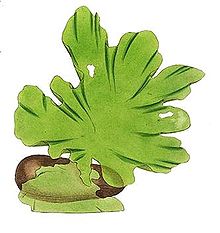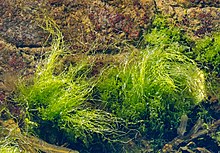
Ulva lactuca, also known by the common name sea lettuce, is an edible green alga in the family Ulvaceae. It is the type species of the genus Ulva. A synonym is U. fenestrata, referring to its "windowed" or "holed" appearance, Despite the name, it is not a lettuce

Gracilaria is a genus of red algae (Rhodophyta) notable for its economic importance as an agarophyte, as well as its use as a food for humans and various species of shellfish. Various species in the genus are cultivated among Asia, South America, Africa and Oceania.
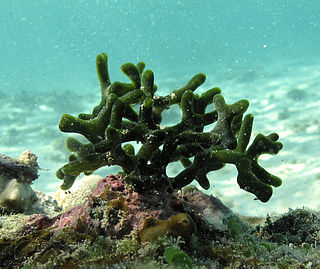
Codium is a genus of edible green macroalgae under the order Bryopsidales. The genus name is derived from a Greek word that pertains to the soft texture of its thallus. One of the foremost experts on Codium taxonomy was Paul Claude Silva at the University of California, Berkeley. P.C. Silva was able to describe 36 species for the genus and in honor of his work on Codium, the species C. silvae was named after the late professor.

Chordariaceae is a family of brown algae. Members of this family are may be filamentous, crustose with fused cells at the base, or they may be terete and differentiated into a central medulla and an outer photosynthetic cortex. They have a sporphytic thallus usually aggregated to form a pseudo-parenchyma.
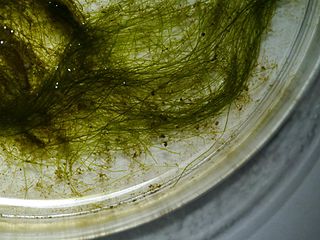
Vaucheria is a genus of Xanthophyceae or yellow-green algae known as water felt. It is one of only two genera in the family Vaucheriaceae. The type species of the genus is Vaucheria disperma.

Ulva intestinalis is a green alga in the family Ulvaceae, known by the common names sea lettuce, green bait weed, gutweed, and grass kelp. Until they were reclassified by genetic work completed in the early 2000s, the tubular members of the sea lettuce genus Ulva were placed in the genus Enteromorpha.

Rhodymenia is a genus of red algae, containing the following species:

Ulva linza is a green alga in the family Ulvaceae that can be found in British Isles.

Plocamium is a genus of red algae in the family Plocamiaceae. It contains around 40 species and has a cosmopolitan distribution in temperate seas, although it is most diverse in the southern hemisphere. It is widely distributed in tropical and also warm-temperate and cold-temperate seas, such as northern Europe, the northern Arabian Sea and western Australia. They are also found in the Antarctic regions of Admiralty Bay and Terra Nova Bay.
Ulva acanthophora is a species of benthic subtropical seaweed in the Ulvaceae family that can be found in California and Mexico.

Ulva chaetomorphoides is a species of tropical and benthic seaweed in Ulvaceae family that can be found in Gulf of Mexico and European waters.

Blidingia marginata is a species of seaweed in the Kornmanniaceae family.
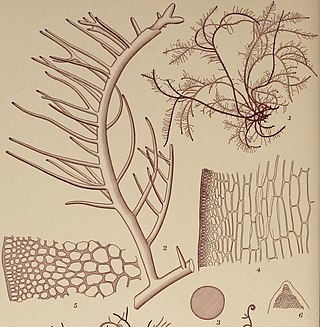
Hypnea is a genus of red algae, and a well known carrageenophyte.

Phyllophoraceae is a family of red algae in the order Gigartinales.
